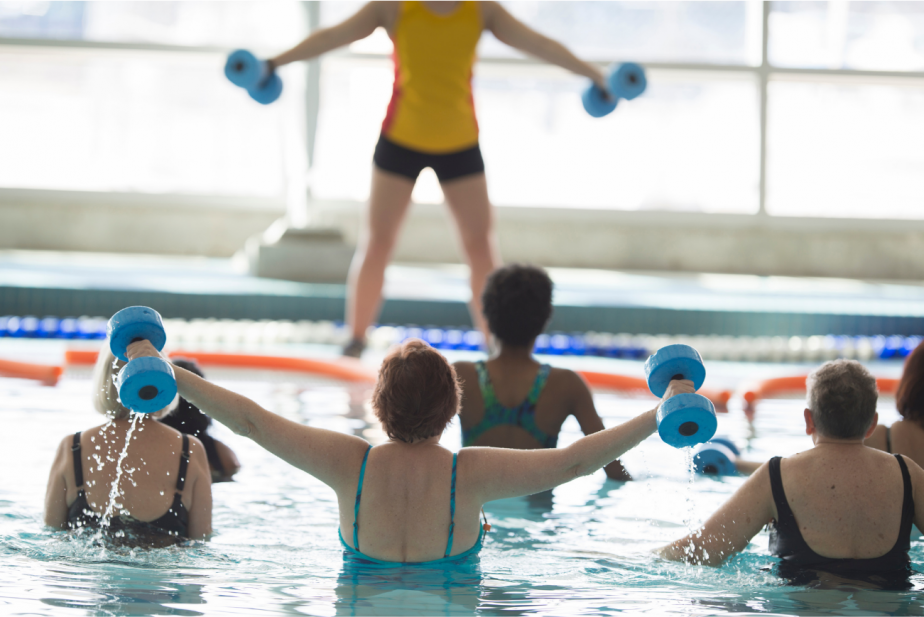Aquaphobia is defined as a persistent and abnormal fear of water and can be a real barrier for some people interested in participating in aquatic exercise. However, there are ways to introduce water exercise to aquaphobes so they also can enjoy this beneficial form of movement. With patience, understanding, and a bit of creativity, a successful water experience is not out of reach for those afraid of the water.
 The fear of water can develop from a variety of sources including a personal, direct experience (almost drowning), an indirect learning experience (witnessing a negative water experience), an auditory experience (reading or hearing a recounted experience) or subconscious learning, through dreams, early childhood experiences, or an innate need for self-protection. Regardless of how someone has developed this phobia, the techniques for overcoming it are the same.
The fear of water can develop from a variety of sources including a personal, direct experience (almost drowning), an indirect learning experience (witnessing a negative water experience), an auditory experience (reading or hearing a recounted experience) or subconscious learning, through dreams, early childhood experiences, or an innate need for self-protection. Regardless of how someone has developed this phobia, the techniques for overcoming it are the same.
As a water-fitness professional, encountering a student that is fearful of the water is very likely. Often this just appears as a fear of the deep end or of drowning in general. If a student arrives at a class and informs you they are afraid, it is possible to help them progress beyond their phobia. Just the fact that they are willing to attempt an aquatic exercise class tell you that the severity of their fear is probably moderate to mild, and that they have already progressed past the most debilitating stage.
Respect is the key when interacting with someone with a phobia. It is a very real experience. Understanding the severity and origin can aid in accommodating their needs. This goes a long way toward helping the student feel safe and comfortable. There are a few simple steps to take to assist the person with aquaphobia.
First, offer the student the opportunity to merely observe their first class from a comfortable place offering clear line of sight and sound. At the end, review some details about water program. For example, the structure of the class, the contact with the pool bottom, the head staying above the water, and the ability of the student to come and simply watch poolside again. A suggestion can be made to remain in the shallow water and wear a flotation belt or hold an aqua noodle to make them feel more at ease.
It may take some time for the client to progress into class, but baby steps, like sitting on the side of the pool, putting their feet in the water, standing in the water, or holding on to the pool side during the workout are helpful. Eventually the student may try some small range of motion movements as their confidence grows and finally release the pool side (with or without the flotation belt.) While this kind of progress can be very encouraging, always remember to respect a client’s needs. Continuous education about water and what it’s like to move in water will be helpful for the fearful participant.

Be certain to focus on the following topics:
Buoyancy: Explain the effect on the body, recognizing the feeling of weightlessness seems like a benefit of water exercise but may not be a welcome sensation to someone who fears water. Educate participants about core engagement to stabilize the body in water.
Water depth: Also, instruct exercisers about appropriate depth of water for successful shallow water exercise. A fearful student may opt to stay in more shallow water at first and gradually move to chest deep water over time.
Levels: There are five levels of exercise in water; Rebound, Power Rebound, Grounded, Neutral, and Suspension. Fearful students may choose to move in the grounded level, eventually adding more rebound as confidence grows. Some may never be comfortable with suspension, so modifications are important. Just remember to respect their fear, be patient, recruit help when necessary and allow the client to set the pace of their own progress.
Equipment: Those with aquaphobia may opt to add a buoyancy belt or hold onto a piece of buoyant equipment like an aqua noodle, kick board, or hand buoy to ensure staying above the water’s surface. Teach students proper technique while using equipment to avoid hand fatigue, shoulder tension or destabilization.
There may come a time when the student has progressed so far that you almost forget they ever had a fear of water, until a traumatic experience occurs causing the person to slip or submerge. The reaction may be mild or a complete breakdown and set-back. Offer assistance but avoid making mention in front of other participants. Know that a regression is possible and may require additional patience and understanding.
Remember that fitness leaders have a unique opportunity to help others progress not only functionally, but also in personally. The confidence gained through completing a group fitness class or maybe even overcoming a fear, has lasting, positive effects outside of the gym and through life.

